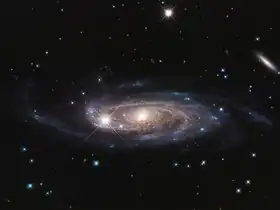UGC 2885
| UGC 2885 | |
|---|---|
 UGC 2885 imaged by the Hubble Space Telescope[1] | |
| Observation data (J2000 epoch) | |
| Constellation | Perseus |
| Right ascension | 03h 53m 02.459s[2] |
| Declination | +35° 35′ 22.17″[2] |
| Redshift | 0.019350±0.000010[3][4] |
| Heliocentric radial velocity | 5,801±3 km/s[3] |
| Galactocentric velocity | 5,870±4 km/s[3] |
| Distance | 274.0 ± 19.24 Mly (84.0 ± 5.9 Mpc)h−1 0.6774 (Comoving)[3] 269 Mly (82.48 Mpc)h−1 0.6774 (Light-travel)[3] |
| Apparent magnitude (V) | 13.5[3] |
| Apparent magnitude (B) | 14.4[5] |
| Characteristics | |
| Type | SA(rs)c[3] |
| Mass | 2 trillion[6][7] M☉ |
| Size | 438,060 ly × 201,500 ly (134.31 kpc × 61.78 kpc) (diameter; 25.0 B-mag arcsec−2)[3][a] 216,110 ly × 90,769 ly (66.26 kpc × 27.83 kpc) (diameter; 20.0 K-mag arcsec−2)[3][a] |
| Apparent size (V) | 5.5′ × 2.5′[8][5] |
| Other designations | |
| TC 49, Z 039.8+3527, IRAS 03497+3526, MCG +06-09-012, PGC 14030, CGCG 526-012[5] | |
UGC 2885 (Rubin's Galaxy,[9] nicknamed "Godzilla galaxy"[10]) is a large barred spiral galaxy of type SA(rs)c in the constellation Perseus. It is 84 megaparsecs (274.0 million light-years) from Earth and measures 134.3 kiloparsecs (438,000 light-years) across, making it one of the largest known spiral galaxies.[3] It is also a possible member of the Perseus–Pisces Supercluster.[11]
UGC 2885 is a spiral galaxy with a relatively low surface brightness,[12] but does not have as low of a surface brightness as other so-called giant low surface brightness galaxies.[13]
UGC 2885 is classified as a field galaxy, being remarkably isolated from other galaxies. It is unknown how it got its cold gas which is necessary for star formation.[13] NASA has reported that the theorized main source for disk growth for UGC 2885 came from the accretion of intergalactic hydrogen gas, rather than through the repeated process of galactic collision, as most galaxies are thought to grow.[10]
The lack of interaction is evident from the near-perfect structure of the spiral arms and disk, lack of tidal tails, and modest rate of star formation—approximately 0.5 solar masses/year.
Additionally, despite being originally classified as an unbarred spiral galaxy, new Hubble images clearly show the presence of a small bar cutting across the ring structure of the core. This is peculiar, as most bars are thought to form through minor gravitational perturbations brought on by satellite and neighboring galaxies, which is something this galaxy lacks. This galaxy highlights that bars are able to form in spiral galaxies without the influence of another galaxy—this indicates that other forces, such as interactions between stars, gas and dust, as well as the gravitational influence of dark matter, might play a role in their development.
One supernova has been observed in UGC 2885: on 17 January 2002, the Katzman Automatic Imaging Telescope discovered SN 2002F (type II, mag. 18.1).[14][15][16][17]
See also
- NGC 6872 and IC 4970 – The largest known spiral galaxy
- Malin 1
- NGC 262
- ESO 383-76
- IC 1101
Notes
- ^ a b The quick-look major axis physical diameters given by NED of 113.75 by 52.33 kiloparsecs (371,000 by 171,000 light-years) and 56.12 by 23.57 kiloparsecs (183,000 by 76,900 light-years) were based on a distance estimate of 71.1 megaparsecs (231.9 million light-years). The quoted diameters in this infobox were based on NED's provided scale "Virgo + GA + Shapley" of 407 parsecs/arcsec multiplied with given angular diameters.
References
- ^ "Hubble Surveys Gigantic Galaxy". www.spacetelescope.org. Retrieved 6 January 2020.
- ^ a b Brown, A. G. A.; et al. (Gaia collaboration) (August 2018). "Gaia Data Release 2: Summary of the contents and survey properties". Astronomy & Astrophysics. 616. A1. arXiv:1804.09365. Bibcode:2018A&A...616A...1G. doi:10.1051/0004-6361/201833051. Gaia DR2 record for this source at VizieR.
- ^ a b c d e f g h i j NASA/IPAC Extragalactic Database. "NED search results for object UGC 02885". Retrieved 2013-09-05.
- ^ Canzian, Blaise; Allen, R. J.; Tilanus, R. P. J. (1993). "Spiral structure of the giant galaxy UGC 2885 – H-alpha kinematics". The Astrophysical Journal. 406: 457. Bibcode:1993ApJ...406..457C. doi:10.1086/172457.
- ^ a b c "UGC 2885". SIMBAD. Centre de données astronomiques de Strasbourg.
- ^ Jeremy Heyl (1980). UGC 2885, the Largest Known Spiral Galaxy (PDF). The University of British Columbia.
- ^ "UGC 2885 – GIANT SIZE Spiral Galaxy". Retrieved 2016-05-17.
- ^ Huchra, John P.; Vogeley, Michael S.; Geller, Margaret J. (1999). "The CFA Redshift Survey: Data for the South Galactic CAP". The Astrophysical Journal Supplement Series. 121 (2): 287. Bibcode:1999ApJS..121..287H. doi:10.1086/313194.
- ^ "APOD: 2020 January 25 – Rubin's Galaxy".
- ^ a b "NASA's Hubble Surveys Gigantic Galaxy | NASA". 2 January 2020.
- ^ "UGC 2885 by jshuder". Retrieved 2018-05-17.
- ^ Lewis, B. M. (1985). "H I observations of supermassive spiral galaxies". The Astrophysical Journal. 292: 451. Bibcode:1985ApJ...292..451L. doi:10.1086/163174.
- ^ a b Carvalho, Matheus C.; Naguleswaran, Bavithra; Barmby, Pauline; Gorski, Mark; Köenig, Sabine; Holwerda, Benne; Young, Jason (2024). "A multi-wavelength overview of the giant spiral UGC 2885". Astronomy & Astrophysics. 692: A105. arXiv:2410.16467. Bibcode:2024A&A...692A.105C. doi:10.1051/0004-6361/202450916.
- ^ "SN 2002F". Transient Name Server. IAU. Retrieved 20 August 2024.
- ^ "UGC 2885, Spiral Galaxy; Supernova 2002 F". Retrieved 2016-05-17.
- ^ "SN 2002F". Archived from the original on 2016-04-04. Retrieved 2018-05-17.
- ^ Swift, B.; Li, W. D. (2002). "Supernovae 2002D, 2002E, 2002F, and 2002G". International Astronomical Union Circular (7797): 1. Bibcode:2002IAUC.7797....1S.